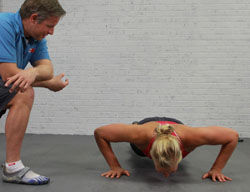
By Jim Gerard
It sounds like the name of a new Latin dance craze, but throughout the fitness world, Tabata (pronounced Tah-bah’-tah) has spread virally as the ultimate version of high-intensity interval training (HIIT) and is frequently—and falsely—advertised as a way to get fit in four minutes a day.
Although he didn’t invent HIIT, Dr. Izumi Tabata, a researcher working with the Japanese national speed-skating team in the mid-1990s, devised the first strictly regimented HIIT protocol—pushing his athletes through eight or more 20/10 cycles of pedaling (at more than 85 RPM) on stationary bikes until they attained a staggering 170 percent of their VO2max (Tabata et al., 1996).
While Tabata is most often done on a bike or treadmill, fitness professionals are adapting it to everything from strength-training equipment to one’s own bodyweight. What stays constant is the protocol—one or more series of eight cycles of 20 seconds of all-out effort followed by 10 seconds of recovery.
“[Izumi] Tabata discovered that combining high-intensity intervals with periods of short recovery was extremely effective at reducing the time of training while increasing his athletes’ fitness levels,” explains Pete McCall, exercise physiologist at the American Council on Exercise. “This turned on its head the prevailing theory for achieving optimal fitness—that you needed to run for many miles to see results. It also began to steer the fitness world away from ‘steady-state’ training—whether a long run or a brisk walk—to HIIT.”
Research has shown that HIIT—whether in the form of CrossFit, P90X or Tabata—improves cardiovascular fitness, increases lean muscle mass and enhances hypertrophy, and is an effective weight-loss tool (Laursen, 2010; Perry et al., 2008; Helgerud et al., 2007).
“When you do HIIT workouts, you use more type II muscle fibers, which are responsible for definition,” McCall says. “Also, high-intensity training stimulates the promotion of testosterone in men and growth hormone in women, which helps muscles rebuild after your workout.” Given these benefits, McCall adds, it was only a matter of time until Tabata, the protocol that stretched high-intensity intervals to the max and promised to do so in the least amount of time, grabbed the spotlight. “People are realizing that they don’t need to kill themselves at the gym for an hour.”
Faster Results in Less Time
Eve Fleck, owner of Gym Without Walls in Los Angeles, attributes Tabata’s popularity to a number of factors. “You can get results more quickly than with conventional training, which appeals to a busy population. Yet the rest interval is short enough so that you never get complete recovery, which makes you work harder. It raises both your aerobic and anaerobic threshold, so it enhances your other workouts and sports.” And, Fleck adds, “It gives you a feeling of accomplishment.”

Is it Really Tabata or Simply Another Form of HIIT?
Patrick Streit, owner of Force Fitness Performance in Cincinnati, uses Tabata with his clients and acknowledges its benefits. “It’s the 20/10 interval that’s caught on,” argues Streit, “and Tabata is just a name they’re appending to it.”
Streit’s assertion raises an interesting question: Is the “Tabata” label being applied to protocols that are not, in fact, true Tabata workouts? After all, as previously mentioned, the original protocol—which was imposed on elite athletes under laboratory conditions five times a week for six weeks—is virtually impossible to replicate with even highly fit exercise enthusiasts. Therefore, workouts advertised as “Tabata” are, in fact, modified versions of the original. As Fleck admits, “We’d never be able to push people to 170 percent of their VO2max.”
Mindy Mylrea, creator of Tabata Bootcamp and past IDEA Instructor of the Year, adds that Tabata is extremely adaptable, and that she has varied the medium to provide more than 100 Tabata-type workouts. Fleck says its adaptability allows her to hold group exercise classes that include people of all fitness levels.
However, Fleck contends that one can make the same claims—save for the 20/10 ratio—for all HIIT training. What separates Tabata from the pack, argues Fleck, is its simplicity: “You can choose one exercise with which to challenge yourself.”
Is Tabata Suitable—or Safe—for Everybody?
All sources in this article agreed that even one four-minute true Tabata was punishing, especially the first time they tried it. “If I put a client through a true Tabata during our first session together,” McCall says, “I’d never see him again.” Streit concurs: “The cool-down would [consist of] lying on the floor.”
There was, however, less consensus among our experts regarding whether even a somewhat adjusted Tabata is appropriate for everyone, especially the deconditioned.
Fleck and Mylrea feel that Tabata can be modified for any fitness level (as long as they adhere to the 20/10 ratio and, as Fleck says, the client is allowed to “move at his or her own pace”). Conversely, Streit says that in all but the “most hardcore” athletes, he gradually works clients up to Tabata-readiness over six months of conventional training.
McCall’s advice falls somewhere in between: “Tabata works best for fitness enthusiasts seeking a way to get improved results, break through a plateau or make training more productive—someone who works out three to four times a week or is training for a long-distance run.”
 Tabata acolytes who claim that “true” Tabata lasts four minutes ignore the fact that the original four-minute workout was sandwiched between a five-minute warm-up and a two-minute cool-down, for a total duration of 11 minutes.
Tabata acolytes who claim that “true” Tabata lasts four minutes ignore the fact that the original four-minute workout was sandwiched between a five-minute warm-up and a two-minute cool-down, for a total duration of 11 minutes.
Their opinions also diverge regarding how many days per week should be devoted to Tabata workouts. McCall advises up to three to four sessions for highly fit clients with specific performance-based goals, while Fleck and Mylrea prefer between one and three. “If you’re doing one day of Tabata, you should do two days of regular [steady-state] exercise,” Fleck says. “Relying solely on Tabata, doing it four to five days a week, would increase the risk of injury.” Streit feels that Tabata needs to be complemented by days committed to strength training.
Still, all agreed that determining how often to do Tabata and who it best serves depends on factors such as the client’s goals and overall health, the extent of his or her non-Tabata workouts (how many days a week are devoted to traditional cardio and weight training) and, perhaps most importantly, the level of intensity of the individual’s Tabata workout(s).
The following sample Tabata workouts provide basic guidelines that can be modified and adjusted to suit each client’s needs and goals. The first sample workout adheres as closely as possible to the original standard, while the second workout offers a modified regimen.
Before embarking on either of these workouts, heed these caveats:
- Obtain clearance from your client’s physician—particularly if he or she has any cardiovascular issues. Streit advises, “Describe [the workout protocol] in detail and make it clear that it’s going to take [the client’s] heart rate up to, or close to, the maximum.”
- Don’t allow the client to participate if he or she is injured.
- Always allow the client to work at his or her own pace.
TABATA WORKOUT #1
Use a stationary bike such as the Schwinn AirDyne spinning model, because its resistance increases the as you pedal harder. Keep in mind that using a treadmill requires the client to jump on and off during each 20/10 cycle, which could increase the risk of injury.
Start with an eight-minute progressive warm-up, gradually increasing in intensity to an intermediate level of 70 percent to 80 percent of VO2max—the point at which the client breaks a sweat.
Begin the first of eight 20/10 Tabata cycles, with the 20-second, high-intensity intervals at 100 percent of VO2max. After 20 seconds, quickly adjust the tension level to its lowest setting (or instruct the client to do so) and lightly coast for 10 seconds, then immediately increase it again. This Tabata cycle totals four minutes. End with an eight-minute cool-down comprised of stretching and lower-intensity bodyweight exercises, such as planks and side planks, to reduce the client’s heart rate. (Total time: 20 minutes)
MODIFIED TABATA WORKOUT #2 (from Patrick Streit)
This complete metabolic conditioning circuit–based, Tabata-style workout utilizes the client’s bodyweight, a kettlebell and a TRX suspension trainer for resistance.

After a five-minute warm-up of myofascial release on a foam roller and dynamic stretching, repeat the following circuits four times:
• 20 seconds of push-ups/10 seconds of recovery
• 20 seconds of TRX recline rows/10 seconds of recovery
• 20 seconds of burpees/10 seconds of recovery
• 20 seconds of kettlebell swings/10 seconds of recovery
To cool down, simply repeat the warm-up. (Total time: 26 minutes)
References
Helgerud, J. et al. (2007). Aerobic high-intensity intervals improve VO2max more than moderate training. Medicine & Science in Sports & Exercise, 39, 4, 665–671.
Laursen, P.B. (2010). Training for intense exercise performance: High-intensity or high-volume training? Scandinavian Journal of Medicine & Science in Sports, 20, (Suppl. 2), 1–10.
Perry, C.G.R. et al. (2008). High-intensity aerobic interval training increases fat and carbohydrate metabolic capacities in human skeletal muscle. Applied Physiology, Nutrition and Metabolism, 33, 1112–1123.
Tabata, I. et al. (1996). Effects of moderate-intensity endurance and high-intensity intermittent training on anaerobic capacity and VO2max. Medicine & Science in Sports & Exercise, 28, 10, 1327−1330.
_____________________________________________________________________

Jim Gerard is an author, journalist, playwright and stand-up comic. He has written for the New Republic, Travel & Leisure, Maxim, Cosmopolitan, Washington Post, Salon, Details, New York Observer, and many other magazines. For more information, visit his site at www.gangof60.com.